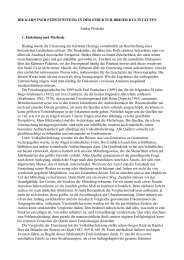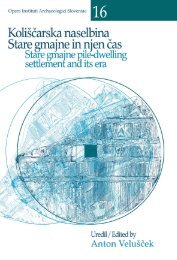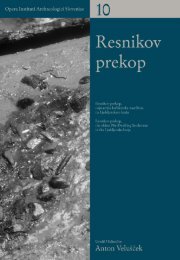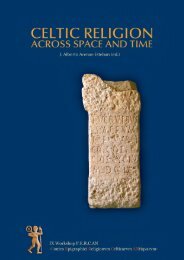The dedication to Antinous from Socanica In the course of ...
The dedication to Antinous from Socanica In the course of ...
The dedication to Antinous from Socanica In the course of ...
Create successful ePaper yourself
Turn your PDF publications into a flip-book with our unique Google optimized e-Paper software.
186 MARJETA ŠAŠEL KOS<br />
would have been regarded as a civic god (37). Perhaps <strong>the</strong> person<br />
mentioned in <strong>the</strong> inscription, Q. Siculius, originated <strong>from</strong> Aquileia;<br />
<strong>the</strong> gentilicium is indeed attested in <strong>the</strong> city (38). Well in<br />
accordance with <strong>the</strong> public opinion, encouraged in <strong>the</strong> time <strong>of</strong><br />
Hadrian, it was asked in <strong>the</strong> epigram, why <strong>Antinous</strong> could not be<br />
regarded as a hypostasis, <strong>the</strong> essence, <strong>of</strong> Belenus.<br />
Three tear-shaped ceramic plaques on which <strong>the</strong> head <strong>of</strong><br />
<strong>Antinous</strong> was depicted were found in Aquileia, as well as a marble<br />
bust. <strong>The</strong> head <strong>of</strong> <strong>Antinous</strong> on <strong>the</strong> plaques is reproduced <strong>from</strong> a<br />
bronze coin <strong>from</strong> Bithynium-Claudiopolis, and it is surrounded<br />
by <strong>the</strong> legend: H PATRIS ANTINOON UEON (“<strong>the</strong> fa<strong>the</strong>rland<br />
[pays honour] <strong>to</strong> <strong>the</strong> god <strong>Antinous</strong>”). On <strong>the</strong> obverse <strong>of</strong> this coin,<br />
which served as <strong>the</strong> pro<strong>to</strong>type for <strong>the</strong> plaques, <strong>Antinous</strong> is depicted<br />
as Hermes (Fig. 4) (39). <strong>The</strong> use <strong>of</strong> <strong>the</strong> plaques is not certain,<br />
but <strong>the</strong>y may have been votive objects, more likely than <strong>the</strong><br />
(symbolic) pieces belonging <strong>to</strong> a wooden sarcophagus (40). <strong>The</strong><br />
mentioned bust was made <strong>of</strong> Greek marble and was originally a<br />
Fig. 4. Tear-shaped ceramic plaques with <strong>the</strong> head <strong>of</strong> <strong>Antinous</strong> <strong>from</strong> Aquileia (<strong>from</strong>: MEYER,<br />
Antinoos, 1991, Pl. 122).<br />
(37) C. ZACCARIA, Alla ricerca di divinità »celtiche« nell’Italia settentrionale in età romana.<br />
Revisione della documentazione per le regiones IX, X, XI, «Veleia», 18-19 (2001-2002), p. 129 ff.<br />
(= Die Kelten und Ihre Religion im Spiegel der epigraphischen Quellen, Akten des 3. F.E.R.C.AN. -<br />
Workshops, eds. J. GORROCHATEGUI, P. DE BERNARDO STEMPEL (Anejos de Veleia 11), Vi<strong>to</strong>ria-<br />
Gasteiz 2004, p. 129 ff.).<br />
(38) <strong>In</strong>Aq 1487; 2482.<br />
(39) P. GUIDA, Piastrelle votive del Museo di Aquileia. Spunti sul cul<strong>to</strong> di Antinoo, «Aquileia<br />
Nostra», 36 (1965), cc. 37-44; cfr. C. ZACCARIA, Piastrella votiva, in <strong>In</strong>strumenta <strong>In</strong>scripta Latina.<br />
Sezione aquileiese (Catalogo mostra Aquileia 1992), Gorizia 1992, pp. 46-47 no. 70.<br />
(40) MEYER 1991 (cit. in n. 7), p. 159.










